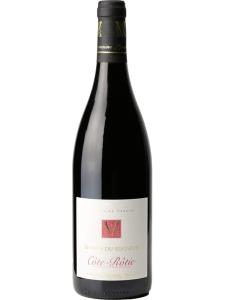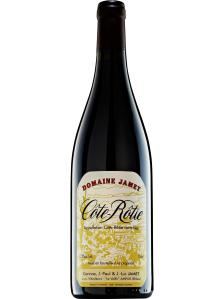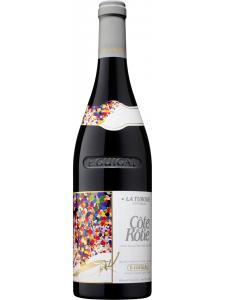Côte Rôtie is a prestigious red-wine appellation at the northern tip of France's Rhône Valley wine region. The Syrah vines on its steep, south-east-facing slopes produce wines which are both powerful and elegant. Improvements in quality have led to increases in demand for the wines – a cycle which turned so consistently that Côte Rôtie wines are now some of France's most sought-after and most expensive.
Situated immediately south of Vienne, the Côte Rôtie is the Rhone Valley's northernmost appellation, and one of its smallest. The parishes of Ampuis, Saint-Cyr-sur-le-Rhone and Tupin-et-Semons are the only three that may produce Côte Rôtie wines, and even within the parishes, only certain plots qualify for the appellation.
(© Christophe Grilhé)
The steep hillsides (côtes) here rise sharply from the banks of the River Rhone to heights of 1150ft (330m). They form 10 narrow ridges no more than 2000ft (600m) wide, each separated from the next by a narrow, tree-lined gully. The ridges run roughly north-east to south-west, providing the sun-baked aspects that help to make the appellation's wines so rich and ripe. The very finest sites – the Côte Brune, Côte Blonde, La Mouline, La Landonne and La Turque – are those immediately above Ampuis town.
Côte Rôtie wines are renowned for being elegant and finely structured, with complex aromas typical of the local terroir and of the Syrah grape variety from which they are made. As is the case in Crozes-Hermitage, an addition of up to 20% of the white variety Viognier is permitted under the appellation law, and producers take full advantage of this to bring elegance and balance to their wines.
There is a recognized distinction between the two main wine styles of the appellation, manifested by the noticeably different wines from two of the title's most prized vineyards. The wines from the Côte Blonde (immediately west of Ampuis) are lighter, fruitier, more sumptuous and approachable at an earlier age. Those from the Côte Brune (immediately above Ampuis) are made in a more structured, tannic, extracted style to capitalize on the effect of the iron soils, and often without an addition of Viognier.
The Côte Blonde is, as its name suggests, a hillside covered with lighter-colored sandy soils and a limestone base. The Côte Brune is no less true to its name, being a slope covered with reddish-brown soils, enriched with iron. The soils of many Syrah/Shiraz-favored vineyards in Australia share this iron-rich soil type, and the temperatures to match. In fact, Côte Rôtie means roasted slope in French, a highly appropriate name for many of the south-facing vineyards, which benefit from maximum exposure to the sun's rays.
Etienne and Marcel Guigal, whose family name is connected with so much high-quality northern Rhône wine, have been given substantial credit for the recent renaissance of the Côte Rôtie and its reputation. For much of the 20th Century, the area was rather neglected and under-developed, with few wine producers capitalizing on its excellent viticultural conditions. The Guigal wines from the La Mouline (Côte Blonde), La Landonne and La Turque (Côte Brune) vineyards grabbed attention all over the world, particularly from consumers and critics in the US, and have helped to establish Côte Rôtie as one of the most dynamic appellations in France.
Supplementary information about Côte Rôtie wines can be obtained from the Rhône Valley's trade body, Inter Rhone.





